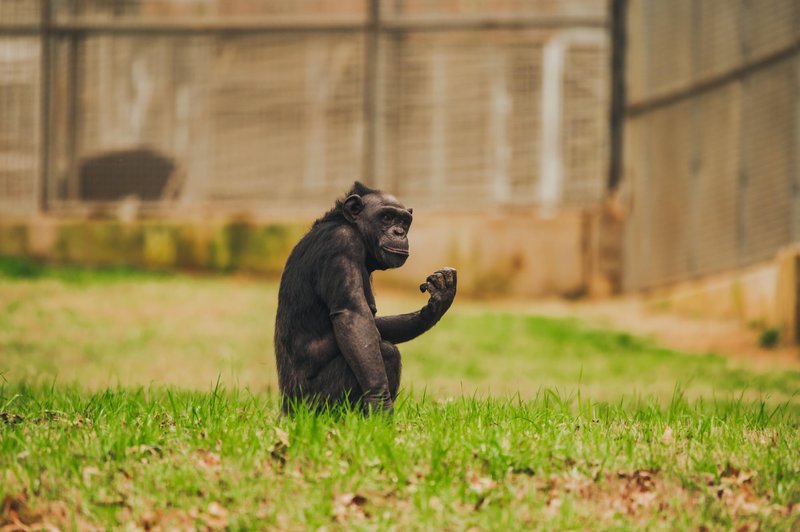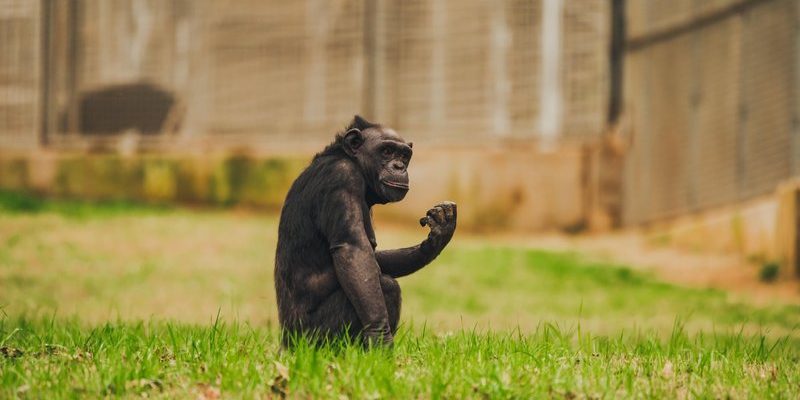
So, let’s dive in together and explore some of these common misconceptions about chimpanzees. From their intelligence and social behavior to their roles in the wild, there’s a lot more to them than meets the eye. Think of this as a fun chat over coffee, where we peel back the layers of what we think we know and get to the heart of the matter!
1. Chimpanzees Are Just Small Humans
One of the biggest myths about chimpanzees is that they are simply small, hairy versions of humans. Sure, they share about 98% of our DNA, but that doesn’t mean they think or behave like us. Honestly, imagining them as tiny people does a disservice to their unique characteristics.
Chimpanzees have their own distinct social structures, communication styles, and behaviors. For example, they rely heavily on vocalizations, gestures, and facial expressions to communicate. You might be surprised to know that they can even use tools! Whether it’s using sticks to fish termites out of mounds or smashing nuts with stones, they have their own innovative ways to adapt to their environment.
Their intelligence is remarkable, but it doesn’t mean they mirror human behavior. It’s essential to appreciate them for who they are, rather than projecting our own traits onto them.
2. Chimpanzees Are Aggressive and Violent
Another common misconception is that chimpanzees are always aggressive and violent creatures. While they certainly have the capacity for violent behavior, just like humans, that’s only part of the story. Most of the time, chimpanzees live peacefully within their communities. They engage in social grooming, play, and build strong bonds within their groups.
When aggression does occur, it’s often related to competition for resources or establishing dominance within the troop. Think about it: just like in human society, tensions can rise when food or space is limited. This doesn’t mean chimpanzees are inherently violent—rather, they respond to their environment in ways that make sense for their survival.
Moreover, their social structure is complex, filled with alliances and friendships that play a significant role in their community dynamics. So, while they can be fierce when necessary, they are also capable of compassion and cooperation.
3. Chimpanzees Are Pets Waiting to Happen
You might have seen videos online of pet chimpanzees doing cute tricks or acting silly, but let me explain why having a chimp as a pet is a terrible idea. First and foremost, chimps are wild animals, not cuddly companions. As they grow, their strength and natural instincts kick in. A baby chimp might be adorable, but they can become aggressive and unpredictable as they mature.
Moreover, caring for a chimpanzee requires specialized knowledge, resources, and a commitment that most people simply can’t provide. In the wild, they roam large territories, socialize with other chimps, and engage in natural behaviors. Keeping them confined to a home simply wouldn’t meet their physical and emotional needs.
So, if you’ve ever thought about bringing a chimpanzee home, it’s best to admire them from afar. Let’s leave them where they belong—out in the wild or in reputable sanctuaries where they can thrive.
4. Chimpanzees Can Mimic Human Behavior Perfectly
While it’s true that chimpanzees can imitate some human actions, the idea that they can perfectly mimic us is misleading. Yes, they are skilled at learning and can copy certain behaviors, but they don’t understand the nuances of those actions like we do.
For instance, a chimp might learn to clap hands or wave, but that doesn’t mean they comprehend the social context behind those actions. They learn through observation, just like children do, but their motivations and understanding differ from ours. It’s important to recognize that their interpretations of these behaviors are shaped by their own perspectives as wild animals.
This distinction is crucial because it emphasizes the unique cognitive skills of chimpanzees without overstating their abilities to replicate human actions.
5. Chimpanzees Are Always Happy and Playful
Chimps are often portrayed as jovial and playful, but here’s the thing: they experience a full range of emotions, just like we do. While they can be playful and engage in fun interactions, they can also feel sadness, frustration, and fear.
Imagine being in a noisy room full of people while you’re having a bad day—you might not want to join in the fun, right? Similarly, chimpanzees might retreat or exhibit signs of distress when they’re feeling overwhelmed or threatened. Their social dynamics can fluctuate, and mood swings are common within their communities.
Recognizing their emotional complexity helps us appreciate them as sentient beings with real feelings and experiences. It’s not just about the cute antics; there’s a deeper emotional life that deserves our respect and understanding.
6. Chimpanzees Are Endangered but Have No Real Impact on Ecosystems
While it’s often cited that chimpanzees are endangered, some people might think their decline doesn’t impact ecosystems much. That couldn’t be further from the truth. Chimpanzees play vital roles in their habitats, especially as seed dispersers. When they eat fruits, they help maintain the health of forests by spreading seeds through their droppings.
Plus, they contribute to the overall balance of their ecosystems. If their populations decline, it can lead to significant changes in vegetation and animal communities. So, their conservation is not just about saving a species; it’s about protecting the intricate web of life in which they play a critical role. Every creature counts, and chimps are no exception!
7. Chimpanzees and Bonobos Are the Same Species
You might hear people refer to chimpanzees and bonobos as if they’re the same, but that’s a common mix-up. While they’re closely related, they are distinct species with key differences. Chimpanzees are typically more aggressive and dominant, whereas bonobos are known for their peaceful and matriarchal societies.
Bonobos use social interactions, including sexual behaviors, to solve conflicts and strengthen social bonds, which is quite different from the typical behaviors of chimpanzees. Understanding these differences helps us appreciate the diverse ways primates can adapt to their environments and navigate their social structures.
So, the next time someone mentions “chimps” generically, you can help set the record straight!
As we wrap up this exploration of common myths and misconceptions about chimpanzees, it’s clear that these remarkable creatures deserve our understanding and respect. By debunking these myths, we not only gain a clearer picture of their lives but also reinforce the importance of conserving their habitats and protecting their populations.
Next time you hear someone share a misconception, you can step in with accurate information. Chimpanzees aren’t just cute animals; they’re complex, intelligent beings with their own societies and challenges. Let’s celebrate them for the unique creatures they are and work together to ensure they have a future in the wild.

